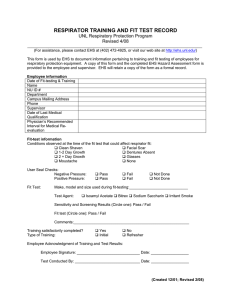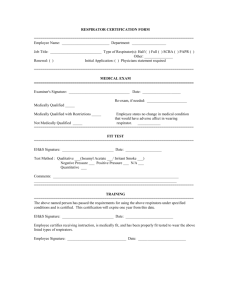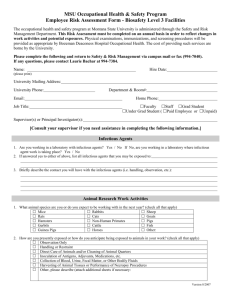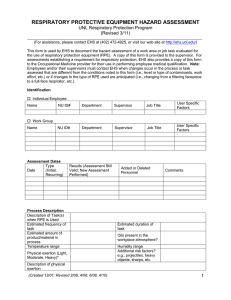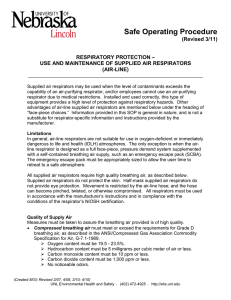Safe Operating Procedure
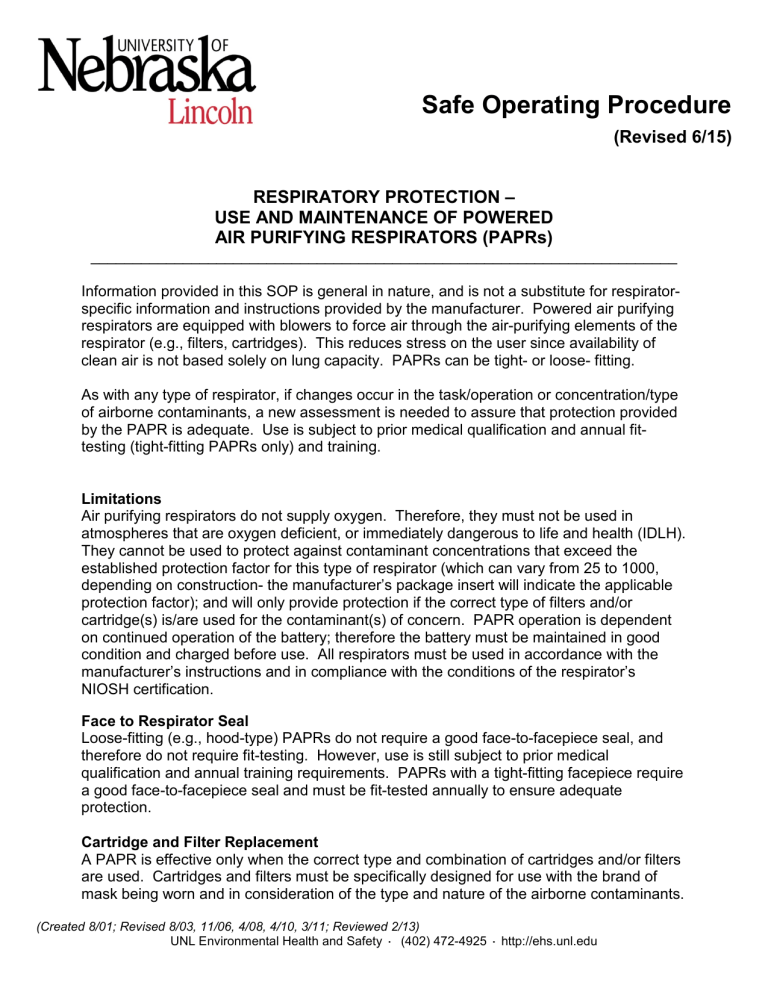
Safe Operating Procedure
(Revised 6/15)
RESPIRATORY PROTECTION –
USE AND MAINTENANCE OF POWERED
AIR PURIFYING RESPIRATORS (PAPRs)
______________________________________________________________________
Information provided in this SOP is general in nature, and is not a substitute for respiratorspecific information and instructions provided by the manufacturer. Powered air purifying respirators are equipped with blowers to force air through the air-purifying elements of the respirator (e.g., filters, cartridges). This reduces stress on the user since availability of clean air is not based solely on lung capacity. PAPRs can be tight- or loose- fitting.
As with any type of respirator, if changes occur in the task/operation or concentration/type of airborne contaminants, a new assessment is needed to assure that protection provided by the PAPR is adequate. Use is subject to prior medical qualification and annual fittesting (tight-fitting PAPRs only) and training.
Limitations
Air purifying respirators do not supply oxygen. Therefore, they must not be used in atmospheres that are oxygen deficient, or immediately dangerous to life and health (IDLH).
They cannot be used to protect against contaminant concentrations that exceed the established protection factor for this type of respirator (which can vary from 25 to 1000, depending on construction- the manufacturer’s package insert will indicate the applicable protection factor); and will only provide protection if the correct type of filters and/or cartridge(s) is/are used for the contaminant(s) of concern. PAPR operation is dependent on continued operation of the battery; therefore the battery must be maintained in good condition and charged before use. All respirators must be used in accordance with the manufacturer’s instructions and in compliance with the conditions of the respirator’s
NIOSH certification.
Face to Respirator Seal
Loose-fitting (e.g., hood-type) PAPRs do not require a good face-to-facepiece seal, and therefore do not require fit-testing. However, use is still subject to prior medical qualification and annual training requirements. PAPRs with a tight-fitting facepiece require a good face-to-facepiece seal and must be fit-tested annually to ensure adequate protection.
Cartridge and Filter Replacement
A PAPR is effective only when the correct type and combination of cartridges and/or filters are used. Cartridges and filters must be specifically designed for use with the brand of mask being worn and in consideration of the type and nature of the airborne contaminants.
(Created 8/01; Revised 8/03, 11/06, 4/08, 4/10, 3/11; Reviewed 2/13)
UNL Environmental Health and Safety · (402) 472-4925 · http://ehs.unl.edu
Cartridges and filters have a limited service life. Some cartridges are equipped with an
End-of-Service-Life (ESLI) indicator. Those that are not equipped with ESLIs must be changed in accordance with a change schedule.
EHS will determine and document an appropriate change-out schedule in consideration of the conditions documented in the Respiratory Protective Equipment Hazard Assessment including manufacturer’s recommendation, OSHA requirements, specific workplace parameters (e.g., humidity, contaminant concentrations, etc.), etc. A copy of the written change schedule will be provided to the employee and their supervisor. Employees must adhere to the established schedule and report to EHS if they experience breakthrough before the end of the predicted service life so that adjustments to the schedule can be made as necessary. Under no circumstances shall a user rely on breakthrough in lieu of the written change schedule.
Equipment Inspection
PAPRs must be inspected prior to each use. Inspection must follow all manufacturer’s recommendations and include but not limited to the following checks:
•
The respirator is clean and ready for use.
•
The proper cartridges are in place, securely mounted, and are not at the end of their service life.
•
The hoses leading from the cartridge to the mask are in good condition.
•
There are no holes, punctures, or tears in the equipment.
•
The lens is not cracked or damaged in a way that may affect performance of the respirator or visibility.
•
The battery is fully charged.
•
Proper airflow is achieved, as tested in accordance with the manufacturer’s recommendations.
Donning on the Equipment
Put on the mask before entering the hazardous environment or beginning a task that will generate an airborne hazard and check to make sure the PAPR is working properly.
•
Mount the belt unit (blower and cartridges) on the waist and adjust the belt until it is
• comfortable. Some equipment may require that the blower be placed in a certain position to allow the breathing tube to reach the mask.
•
Connect the breathing tube to the mask.
Put on the mask. Follow the manufacturer’s recommended procedures. In general,
• tight-fitting facepieces are donned in the same manner as half- or full-face air purifying respirators. Loose-fitting hoods are simply slipped over the head.
If using a tight-fitting PAPR, check the facepiece fit.
o
Block off the breathing tube with the palm of the hand. Breathe in and hold breath for 10 seconds. If the seal is good, the facepiece will collapse and remain against the face. If there is leakage or the facepiece does not remain collapsed, remove and reposition to obtain a good fit. If a good seal is not obtained by repositioning the fitting straps, check other components for leaks
(i.e., breathing tube). Do not use the respirator until a good fit is obtained.
•
Turn on the blower.
(Created 8/01; Revised 8/03, 11/06, 4/08, 4/10, 3/11; Reviewed 2/13)
UNL Environmental Health and Safety · (402) 472-4925 · http://ehs.unl.edu
•
Attach the breathing tube to the blower.
Working While Wearing the Equipment
Know the hazards of the airborne contaminants and the signs and symptoms of exposure.
Discontinue work, leave the area, and notify your supervisor and EHS immediately if experiencing signs or symptoms of exposure. Seek medical attention, if necessary.
•
If chemical odors are detected while wearing a PAPR, it may be a sign that the cartridges need to be replaced or that the facepiece seal is inadequate. Stop working, leave the area, wash hands and face, and check the fit, if applicable. If the fit is adequate, change the filters and/or cartridges. If the problem persists, stop work and do not resume until the problem has been identified and corrected.
•
If eye irritation is experienced while wearing a full face PAPR, this may also be an indication that the cartridge needs changing or that the facepiece seal is inadequate.
Leave the area, wash hands, face, and flush eyes. If the eye irritation persists seek medical attention. If the eye irritation was slight and abates, reposition the respirator and check the fit, if applicable. If the eye irritation persists after resuming work, and the fit is adequate, repeat the steps above and change the filters and/or cartridges. If the problem still persists, stop work and do not resume until the problem has been identified and corrected. Report any breakthrough that occurs before the end of the required change out period to EHS.
•
If the battery begins to fail while wearing the respirator, leave the area and install a freshly charged battery or recharge the battery before continuing use.
Cleaning the Respirator
Follow the manufacturer’s cleaning and disinfection recommendations. This generally involves washing the hood and helmet with mild soap and water, followed by disinfection; wiping of the exterior surfaces of the battery pack and breathing tube; changing cartridges as needed; inspecting equipment for problems; and charging the battery.
Storage of the Respirator
Store the equipment as directed by the manufacturer. The respirator should be stored in a designated clean location away from chemicals, dusts, sunlight, and extreme temperatures. Store in a manner that will prevent the respirator from becoming damaged or deformed.
The information provided in this SOP supplements the UNL Respiratory Protection Program. Refer to the full program document for more information.
See also 2 videos provided by the US Department of Labor, Occupational Safety and Health Administration:
1. The Difference Between Respirators and Surgical Masks
2. Respirator Safety, Donning (Putting on) and Doffing (Taking off) and User Seal Checks
(Created 8/01; Revised 8/03, 11/06, 4/08, 4/10, 3/11; Reviewed 2/13)
UNL Environmental Health and Safety · (402) 472-4925 · http://ehs.unl.edu
